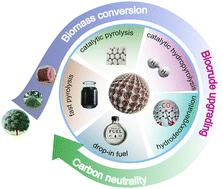可持续生物燃料生产中木质纤维素生物质热解和催化升级的研究进展:工艺设计策略和反应原理
IF 9.2
1区 化学
Q1 CHEMISTRY, MULTIDISCIPLINARY
引用次数: 0
摘要
生物质热解为生产可再生燃料和化学品提供了一条很有前途的途径,大大减少了对化石资源的依赖。然而,常规热解产生的生物油富含氧气,导致其酸度高、热稳定性差、腐蚀性强、含水量过高等不良性能,给下游改造带来困难。为了克服这些挑战,各种上游(如改性快速热解、催化热解、催化加氢热解等)和下游(如加氢脱氧、催化裂化、酯化)的策略已经被开发出来,以有效地去除氧气,提高生物油的质量。尽管大量的研究已经分别解决了这些方法,但全面审查它们对生物油性质和催化剂性能的综合影响仍然有限。此外,虽然常见的模型化合物如愈创木酚和苯酚经常被研究,但真正的生物原油含有大量多芳烃(PAHs)的复杂混合物,会显著加速催化剂失活,这是一个关键但经常被忽视的问题。本文综述了生物质热解技术和催化升级策略的最新进展,强调了双功能催化剂和氢供体在减少焦炭形成、延长催化剂寿命和提高生物油质量方面的作用。催化加氢热解是一种直接从生物质中生成高质量碳氢化合物的有效的单步热解方法。此外,我们强调了采用现实的混合模型化合物(酚类和多环芳烃)和连续流反应器条件来准确代表工业过程和催化剂失活机制的重要性。最后,指出了催化剂稳定性、产品选择性、氢需求、可扩展性和技术经济考虑等关键研究缺口和规模挑战,为未来的研究提供了明确的方向。通过整合热解和升级策略方面的知识,本综述旨在指导开发更高效、经济可行和可持续的商业生物燃料生产途径。本文章由计算机程序翻译,如有差异,请以英文原文为准。

Advances in lignocellulosic biomass pyrolysis and catalytic upgrading for sustainable biofuel production: process design strategies and reaction rationales
Biomass pyrolysis offers a promising route toward renewable fuels and chemicals, significantly reducing reliance on fossil-based resources. However, conventional pyrolysis produces bio-oils rich in oxygen, resulting in undesirable properties such as high acidity, poor thermal stability, corrosiveness, and excessive water content, which complicate downstream upgrading. To overcome these challenges, various upstream (e.g., modified fast pyrolysis, catalytic pyrolysis, catalytic hydropyrolysis, etc.) and downstream (e.g., hydrodeoxygenation, catalytic cracking, esterification) strategies have been developed to efficiently remove oxygen and enhance bio-oil quality. Although substantial research has addressed these methods individually, comprehensive reviews that examine their collective impacts on bio-oil properties and catalyst performance remain limited. Furthermore, while common model compounds like guaiacol and phenol are frequently studied, real biocrudes contain complex mixtures of bulky polyaromatic hydrocarbons (PAHs), significantly accelerating catalyst deactivation, a critical yet often overlooked issue. This review critically assesses recent advances in biomass pyrolysis techniques and catalytic upgrading strategies, emphasizing the roles of bifunctional catalysts and hydrogen donors in minimizing coke formation, prolonging catalyst lifetime, and enhancing bio-oil quality. Catalytic hydropyrolysis is highlighted as an effective single-step method for generating high-quality hydrocarbons directly from biomass. Additionally, we underscore the importance of employing realistic mixed-model compounds (phenolics and PAHs) and continuous-flow reactor conditions to accurately represent industrial processes and catalyst deactivation mechanisms. Finally, key research gaps and scale-up challenges, including catalyst stability, product selectivity, hydrogen requirements, scalability, and techno-economic considerations, are identified, providing clear directions for future research. By integrating knowledge across pyrolysis and upgrading strategies, this review aims to guide the development of more efficient, economically viable, and sustainable pathways toward commercial biofuel production.
求助全文
通过发布文献求助,成功后即可免费获取论文全文。
去求助
来源期刊

Green Chemistry
化学-化学综合
CiteScore
16.10
自引率
7.10%
发文量
677
审稿时长
1.4 months
期刊介绍:
Green Chemistry is a journal that provides a unique forum for the publication of innovative research on the development of alternative green and sustainable technologies. The scope of Green Chemistry is based on the definition proposed by Anastas and Warner (Green Chemistry: Theory and Practice, P T Anastas and J C Warner, Oxford University Press, Oxford, 1998), which defines green chemistry as the utilisation of a set of principles that reduces or eliminates the use or generation of hazardous substances in the design, manufacture and application of chemical products. Green Chemistry aims to reduce the environmental impact of the chemical enterprise by developing a technology base that is inherently non-toxic to living things and the environment. The journal welcomes submissions on all aspects of research relating to this endeavor and publishes original and significant cutting-edge research that is likely to be of wide general appeal. For a work to be published, it must present a significant advance in green chemistry, including a comparison with existing methods and a demonstration of advantages over those methods.
 求助内容:
求助内容: 应助结果提醒方式:
应助结果提醒方式:


